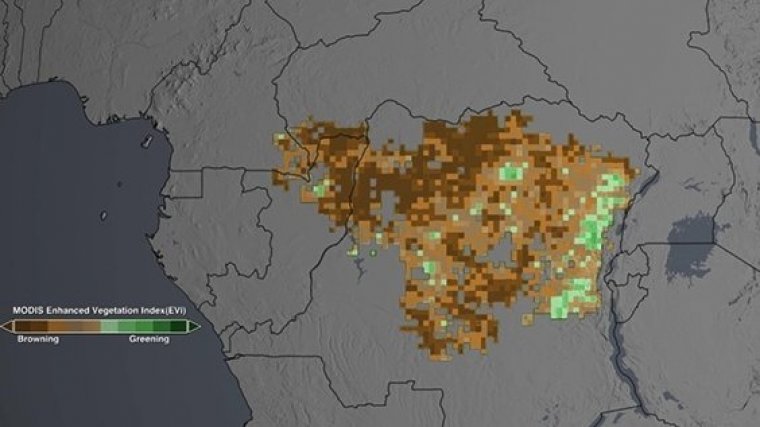| News / Space News |
NASA finds drought may take toll on Congo rainforest
NASA | APRIL 24, 2014
A new analysis of NASA satellite data shows Africa's Congo rainforest, the second-largest tropical rainforest in the world, has undergone a large-scale decline in greenness over the past decade.

A view of the entire African rainforest area (green) transitions into a view of the region included in the Nature study, primarily in the Congo forest (mostly brown). Credit: NASA/Goddard Space Flight Center Scientific Visualization Studio.
Scientists use the satellite-derived "greenness" of forest regions as one indicator of a forest's health.
While this study looks specifically at the impact of a persistent drought in the Congo region since 2000, researchers say that a continued drying trend might alter the composition and structure of the Congo rainforest, affecting its biodiversity and carbon storage.
Previous research used satellite-based measurements of vegetation greenness to investigate changes in the Amazon rainforest, notably the effects of severe short-term droughts in 2005 and 2010.
Until now, little attention has been paid to African rainforests, where ground measurements are even sparser than in the Amazon and where droughts are less severe but last longer.
The study found a gradually decreasing trend in Congo rainforest greenness. The decrease, sometimes referred to as "browning," suggests a slow adjustment to the long-term drying trend. This is in contrast to the more immediate response seen in the Amazon, such as large-scale tree mortality, brought about by more episodic drought events.
The browning of the forest canopy is consistent with observed decreases in the amount of water available to plants, whether that is in the form of rainfall, water stored in the ground, water in near-surface soils, or water within the vegetation.
Climate factors known to affect vegetation growth were also in line with the observed browning. Land surface temperatures, for example, were observed to increase over most of the study area.
Decreased cloudiness allowed more solar radiation to reach the plants, which typically promotes photosynthesis, but in this case it likely posed an extra stress on the plants from the resulting depletion of soil moisture.
YOU MAY ALSO LIKE




